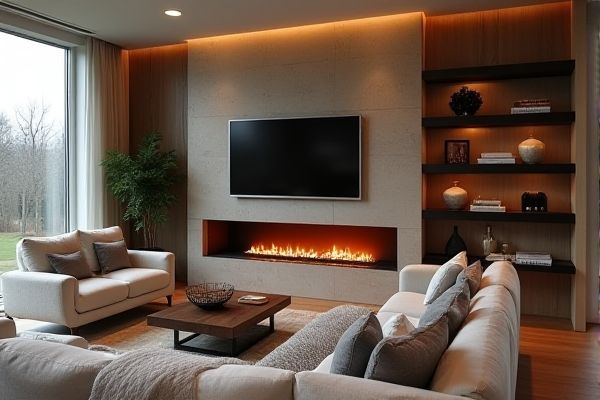
Electric fireplaces offer easy installation, low maintenance, and energy efficiency, making them a convenient choice for creating ambiance without venting requirements. Gas fireplaces provide a more authentic flame experience and reliable heating, ideal for those seeking warmth and atmosphere; explore this article to discover which option best suits your home and lifestyle.
Table of Comparison
| Feature | Electric Fireplace | Gas Fireplace |
|---|---|---|
| Installation | Easy, plug into standard outlet | Requires professional gas line connection |
| Cost | Lower initial and maintenance costs | Higher upfront and maintenance expenses |
| Heat Output | Moderate, suitable for small rooms | High, effective for heating larger spaces |
| Fuel Source | Electricity | Natural gas or propane |
| Emissions | No emissions | Produces combustion gases, requires ventilation |
| Maintenance | Minimal, mainly cleaning | Regular inspection and cleaning required |
| Operation | Simple on/off switch, remote control options | Thermostat control, may need ignition system |
| Safety | Cooler surfaces, lower risk of fire | Hot surfaces, risk of gas leaks |
| Visual Appeal | Simulated flames, customizable LED effects | Real flames, authentic ambiance |
Introduction to Electric and Gas Fireplaces
Electric fireplaces provide a versatile heating solution with easy installation and low maintenance, using infrared or ceramic technology to simulate realistic flames without venting requirements. Gas fireplaces burn natural gas or propane, offering higher heat output and authentic flames, but require proper venting and professional installation. Both options vary in energy efficiency, cost, and environmental impact, catering to different preferences and home setups.
Energy Efficiency Comparison
Electric fireplaces convert nearly 100% of the electricity they use into heat, making them highly energy efficient with minimal heat loss. Gas fireplaces typically achieve 70-90% efficiency, as some heat escapes through ventilation and exhaust systems. Your choice depends on whether you prioritize maximizing energy use or enjoying the ambiance and warmth of a traditional gas flame.
Installation Requirements and Considerations
Electric fireplaces require minimal installation, often needing only a standard electrical outlet, making them suitable for apartments and locations without existing chimneys. Gas fireplaces demand a professional installation involving venting systems, gas lines, and adherence to local building codes, which can increase initial costs and complexity. Proper ventilation and clearance around gas fireplaces are critical for safety, whereas electric models allow more flexible placement within a room.
Cost Analysis: Initial and Long-Term Expenses
Electric fireplaces typically have lower initial costs, ranging from $300 to $2,000, compared to gas fireplaces, which can cost between $2,000 and $5,000 including installation. Long-term expenses favor electric models due to their lower operational costs, averaging $0.15 to $0.30 per hour, while gas fireplaces incur higher fuel costs with natural gas prices varying regionally. Maintenance costs for gas fireplaces are also higher, requiring annual inspections and servicing, whereas electric fireplaces have minimal maintenance needs.
Heating Performance and Output
Electric fireplaces typically offer adjustable heat settings with output ranging from 400 to 1500 watts, suitable for heating small to medium rooms efficiently without additional ventilation. Gas fireplaces provide higher heating performance, often producing between 15,000 to 40,000 BTUs, making them ideal for larger spaces and continuous heat output. Your choice depends on heating needs, with gas fireplaces delivering stronger warmth and electric units offering safer, vent-free operation.
Maintenance and Durability
Electric fireplaces require minimal maintenance, typically involving occasional cleaning of the glass and dusting of internal components, and they offer long-lasting durability with fewer mechanical parts prone to wear. Gas fireplaces demand regular inspection and servicing of gas lines, burners, and ventilation systems to ensure safe operation and prevent carbon monoxide leaks, impacting long-term upkeep costs and reliability. Both options provide durable heat sources, but electric fireplaces generally offer a lower-maintenance solution with extended lifespan under normal usage conditions.
Safety Features and Concerns
Electric fireplaces offer enhanced safety with no real flames, reducing risks of burns, gas leaks, or carbon monoxide poisoning, making them ideal for families and pets. Gas fireplaces require proper ventilation and regular maintenance to prevent potential hazards such as gas leaks or incomplete combustion, which can pose serious health risks. Both options benefit from built-in safety mechanisms like automatic shut-off features and flame failure devices, but electric models generally provide a safer environment for indoor use.
Environmental Impact and Sustainability
Electric fireplaces produce zero direct emissions, making them a cleaner option compared to gas fireplaces that burn natural gas or propane, releasing carbon dioxide and other pollutants. The environmental impact of electric fireplaces depends largely on the electricity source, with renewable energy significantly reducing their carbon footprint. Gas fireplaces, while efficient for heat output, contribute to greenhouse gas emissions, making electric models more sustainable when paired with green energy solutions.
Design Options and Customization
Electric fireplaces offer diverse design options and customizable features, including adjustable flame colors, intensity, and realistic ember bed effects that can suit various interior styles. Gas fireplaces provide classic aesthetics with a wide range of mantel and surround designs, and many models allow you to choose between different burner types, such as logs or glass beads, to enhance ambiance. Your choice depends on whether you prefer the versatile modern customization of electric models or the traditional, authentic look available with gas fireplaces.
Choosing the Best Fireplace for Your Home
Electric fireplaces offer easy installation, low maintenance, and energy efficiency, making them ideal for smaller spaces or apartments. Gas fireplaces provide authentic flames, higher heat output, and can serve as primary heating sources, suitable for larger rooms or homes with existing gas lines. Choosing the best fireplace for your home depends on your heating needs, budget, and installation preferences to ensure comfort and style.
 homyna.com
homyna.com